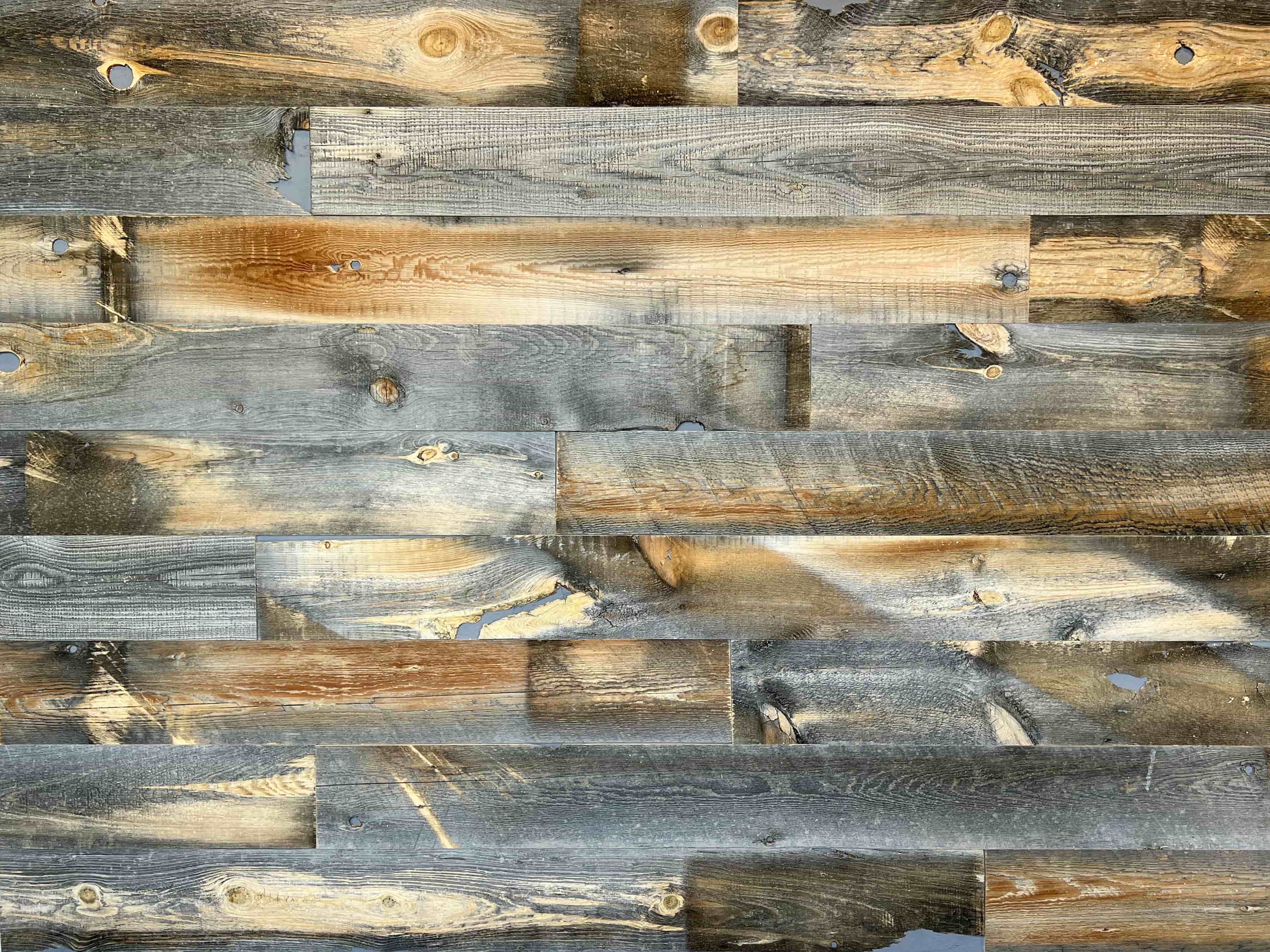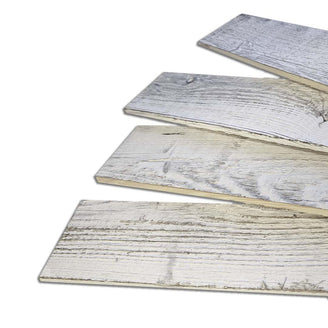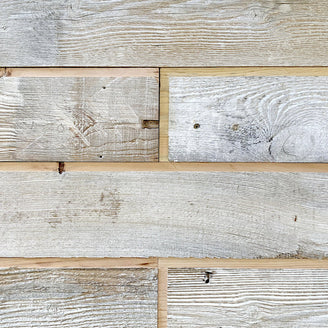If you're exploring interior design trends, you've likely noticed the abundant use of wood paneling, a trend largely influenced by popular TV show designers like Chip and Joanna Gaines’ show Fixer Upper. This unique element brings historic homes and interior walls to life, transforming walls into conversation starters. But with all this talk about wood paneling, how many types are there? And how much does the type you use matter?
The Short Answer: The 6 common types of wood paneling are…
-
Beadboard
-
Shiplap
-
V-groove
-
Board and batten
-
Tongue and Groove
-
Flat Panels
Types of Wooden Paneling
Beadboard
Being a traditional style of wooden paneling, beadboard is steeped in history, showing its charm in a range of interior decor from rustic country to Victorian, Colonial, and country styles. Identifiable by its series of small, vertical wood planks stationed side by side, beadboard creates a textured, striped effect on the wall. The look is achieved using specially crafted planks, each featuring dual line patterns running along the edge at standard intervals. Thanks to its unique design, beadboard panels are easy to clean and maintain, making them particularly favored in rooms like kitchens and bathrooms that demand practicality alongside aesthetics.
Shiplap
Mirroring the aesthetic of homes in the countryside, shiplap paneling adds a laid-back, rustic charm that's hard to resist. Comprising horizontal planks of wood positioned to overlap, shiplap paneling stands out with its series of bands or channels running across the wall. Each plank is milled with a precise groove, known as a rabbet, along the top and bottom edges to lock the boards tightly together, resulting in its hallmark shadow-line effect.
V-groove
Sharing similarities with shiplap, V-groove panels introduce a slight variation in design that delivers a different aesthetic appeal. Instead of flat edges, V-groove panels are milled with chamfered or beveled edges that create a characteristic groove, shaped like the letter 'V', where two planks meet. This subtle detail adds depth to the wall treatment, making V-groove a preferred choice when a hint of traditional elegance is desired.
Board and Batten
Marrying contrasting elements, board and batten paneling bring together wide boards and narrow wooden strips (or battens) installed vertically. The battens are placed over the seams between the wider boards, creating a pattern of alternating wide and narrow vertical panels. This multi-textural approach yields a visually delightful contrast that invokes a sense of old-world craftsmanship.
Tongue and Groove
In the tongue and groove system, each wooden board is specially designed with a protruding 'tongue' on one edge and a recessed 'groove' on the other. When installed, the tongue of one board snugly fits into the groove of the next, forming a solid, flat surface that's pleasing to the eye. This intricate interlocking mechanism ensures a tight fit and imparts a clean, streamlined look to the walls.
Flat Panels
Embracing the classic mantra less is more, flat panels offer a clean, minimalistic alternative in the world of wooden paneling. These panels present a smooth, unembellished surface, framed by a set of rails and stiles. The simplicity of flat panels makes them an excellent choice for contemporary and modern interiors.
Consider the Look, Rather than the Type
While understanding the types and technicalities can be a fun interior design adventure, it's essential to remember that these terms are often used interchangeably within the design industry to describe the appearance of the paneling. For example, when people refer to barn wood, they are likely looking for the aesthetic appeal of reclaimed, red wood that looks like barn wood rather than wood specifically sourced from an old barn. Another example would be shiplap, which many people refer to when looking for salvaged wood that is less perfectly cut and offers a desired rustic appeal for DIY projects.
The Importance of Sustainable Reclaimed Wood
Wood paneling is more than an aesthetic decision; it's an environmental one. Different wood sources impact our planet differently, which makes understanding sustainable wood paneling key.
Non-Sustainable Wood Cutting Practices
Non-sustainable wood-cutting practices are unfortunately common and significantly damaging to our environment. Trees are indiscriminately cut down from forests without a regulated steward overseeing sustainability. Once a tree is extracted, the biodiversity of the forest is severely affected, often leading to unprecedented ecological imbalance.
This method of uncontrolled deforestation is particularly prevalent in the extraction of exotic woods like teak and mahogany. Harsh, damaging practices result in a significant decline in these exotic tree species, contributing to the harmful shrinking of various global forests. This absence of vigilance and regulatory control leaves a harmful impact on the environment that is difficult to reverse.
Natural Wood from FSC-Controlled Forests
Environment-friendly alternatives exist, such as natural materials from Forest Stewardship Council® (FSC®) controlled forests. As an international non-profit organization, the FSC® dedicates its work to advocating for responsible forest management. They guarantee that the wood produced has been harvested responsibly without causing harm to the forest ecology. FSC® certification ensures responsible forest management, helping to minimize the environmental impact of wood harvesting.
Reclaimed Wood: A Sustainable and Aesthetic Choice
Perhaps one of the most environmentally friendly and unique options is reclaimed wood. This type of wood is sourced from old structures, such as old barns, industrial structures, or fences. Not only does this process prevent further deforestation, but it also reduces waste, as these materials would otherwise end up in landfills or burned.
Reclaimed wood paneling offers a level of authenticity and character that other materials can't compete with. It brings with it years of history, natural weathering, and texture that adds depth and character to any space. Every knot, nail hole, and grain pattern tells a story and adds a unique dimension to the aesthetic, making each piece truly one-of-a-kind. Moreover, the use of reclaimed wood aligns with the growing trend of upcycling, supporting environmental sustainability while delivering beautiful home improvement projects.
Choosing the Right Wood Paneling for Your DIY Project
Selecting the right wood paneling goes beyond just identifying the type and its sustainability. You need to factor in the dimensions of your home improvement project, the style you envision, and the desired aesthetic outcome.
Assess Your Project's Scale
Wood paneling works well in many spaces and on varying scales. If you're eyeing a small accent wall to serve as a focal point of the room, consider the wood wall panels that align most with your interior décor choices. Uneven boards like salvaged wood paneling would make a strong visual statement in such a scenario.
For covering an entire wall or room, you might want to choose something subtler or buy in bulk to save on costs. Vertical paneling, like beadboard paneling, adds visual height and works well in larger installations like dining rooms or living rooms without overwhelming the space.
Explore Different Styles and Finishes
The style and color of the wood paneling you choose can significantly alter the mood and aesthetic of your room.
For a more rustic, farmhouse style, red barn wood style paneling offers that desirable worn-in, cozy aesthetic that's been increasingly popular in recent years. Whitewashed paneling, on the other hand, can provide a softer, contemporary look, blending well in modern homes.
The wood plank's texture adds another layer of consideration. Smooth finishes lend themselves to a more modern, sleek look, while rough textures can enhance the authenticity of a rustic design.
Let Your Room Guide Your Choice
Every room has its unique features and functions, so allow these elements to guide your wood wall paneling choice. For instance, dark wooden wall paneling might work well in a bedroom, adding warmth and texture to the space, while white wood paneling is often a popular choice for kitchens. By taking into account your project's scale, the desired aesthetic, the room's functionality, and the importance of choosing sustainably sourced wood, you can confidently select the right type of wall paneling for your DIY project.
How Centennial Woods Can Help
At Centennial Woods, we understand the value of history, uniqueness, and sustainability. We are the world's largest supplier of sustainable reclaimed wood and proudly repurpose weathered wood from hundreds of miles of snow fences lining Wyoming's roadways. These fences, standing 12 feet tall, serve a crucial role in winter driving safety, reducing snowdrifts on the highway, and keeping trade moving. But after 7 to 10 years, these wood boards get a new lease of life.
We give this reclaimed wood a second life as interior and exterior products, including wall and ceiling paneling, siding, and decor items. This means that when you choose paneling from Centennial Woods, you're not only getting a product with a unique history and authentic weathered look, but you're also choosing to reduce waste and support sustainability by sourcing your wood from an FSC® certified company.
So, whether you're planning a small accent wall, paneling an entire room, or even tackling a larger exterior project, Centennial Woods is here to help. Explore our range of reclaimed wood paneling, and discover how you can make your interior space pop!




















